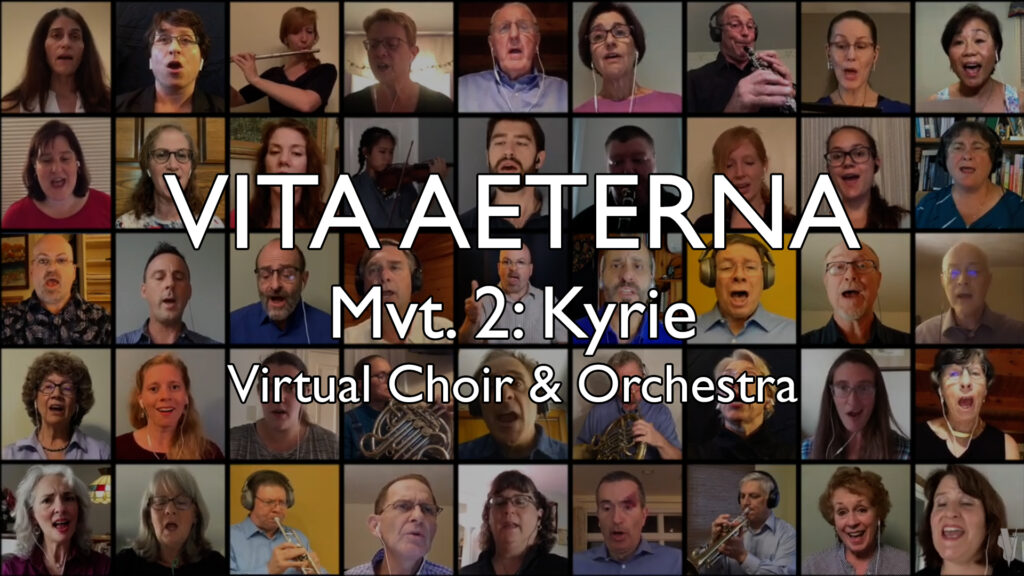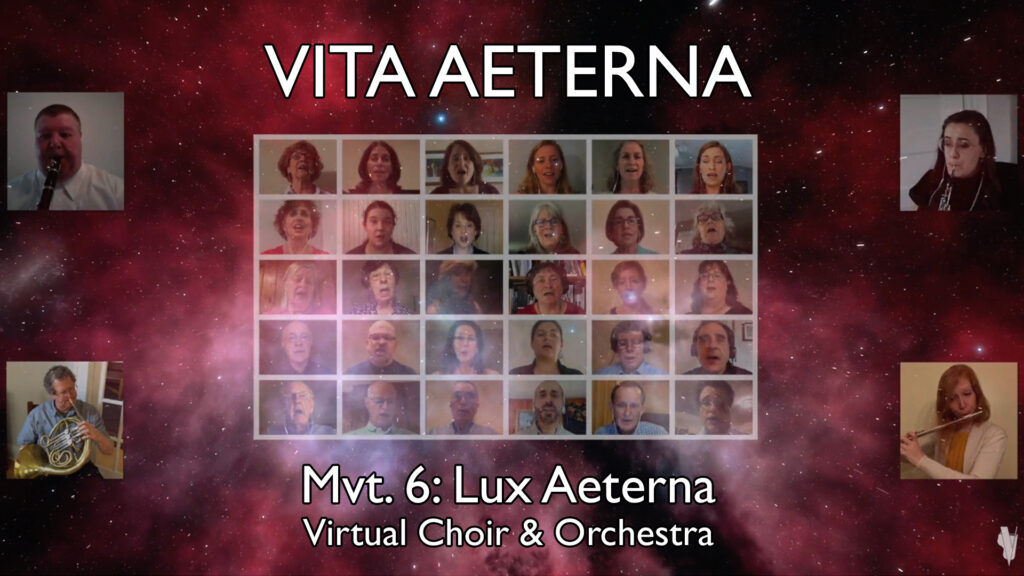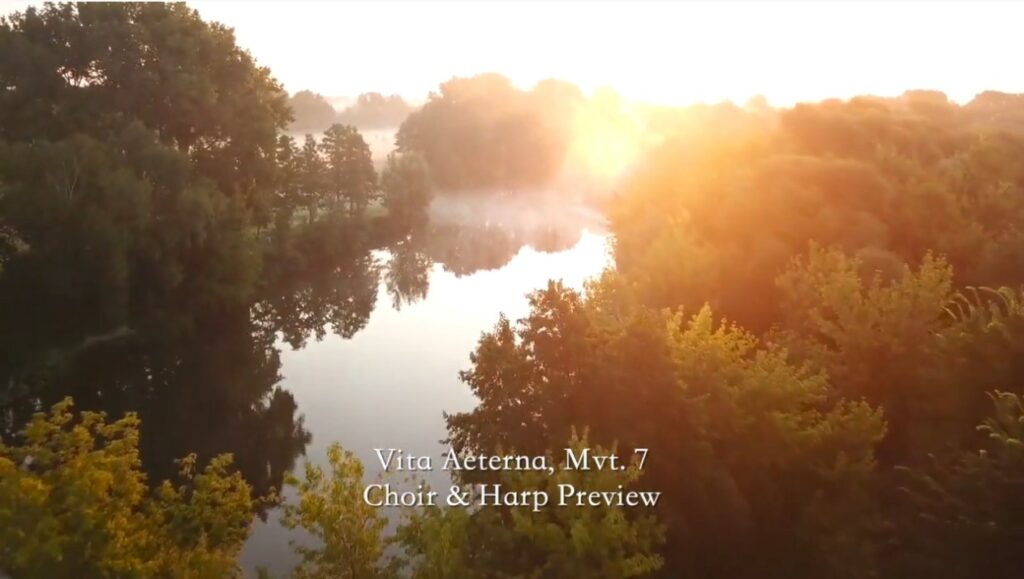VIta Aeterna: The Story & Music


The premiere of Vita Aeterna was recorded virtually over a period of a year from July 2020 to July 2021. The original intent was for this cantata to be premiered live on the concert stage as a complete multi-movement work, but the COVID-19 pandemic changed all that. Nearly 100 singers and instrumentalists participated virtually from across the globe, with locations including Canada, Germany, Great Britain, The Netherlands, and the United States from coast to coast. Recording virtually, where each person sings or plays their part by themselves while listening to a guide recording, is not the ideal performance vehicle for a work of this scope. However, since it was the only option during a worldwide pandemic that witnessed the complete shutdown of all live music opportunities, strangely enough it provided the unanticipated benefit of involving people that would not have been able to participate due to distance. So even while we were apart for so long, music still brought us together.
The links below will take you to the video performance of each moment as well as the full premiere and some bonus material. For those interested in a deeper dive, liner notes are included below that make an attempt at explaining the thought process behind this work, but the music is meant to be experienced on its own. The liner notes are supplemental and not necessary for a significant listen. You can download the program from the premiere performance, which includes a listing of performers, texts in Latin and English, and additional notes.
PROGRAM NOTES (from the composer)
Over the years I have seen first-hand how music has the power to heal, bridge the greatest of divides, and inspire hope in people from every walk of life. It has always been a goal of mine to create music that draws people into the Presence of God, whether it is solely through listening or actively participating in the music itself. This is a big part of why I became a composer, and why I wrote Vita Aeterna (“Eternal Life”).
In 1989, a spark was ignited at a choral music conference in Florida. I was still in college and recently had begun my first church music ministry position. I was searching for God as well as my niche in the music world. The clinician selected Maurice Durufle’s Requiem (meaning “rest”) for us to sing with a full orchestra. It was an incredible musical and spiritual experience for me. Shortly after that conference, I immersed myself in choral repertoire. For some reason I kept coming back to the Requiem form, but my faith in Christ placed on my heart an understanding of “the great beyond” as not just being eternal rest, but eternal LIFE—and eventually discovering that this is something we can begin to experience even now just blew me away (see John 17:3)!
The combining of Latin and English texts was inspired by John Rutter’s Requiem, while the arc of the cantata was loosely inspired by the Fibonacci sequence where in this case the climax occurs about two-thirds of the way through the work during the fifth movement. The “Sanctus” is typically where the climax occurs as a way of amplifying the concept of God’s holiness. Yet in this work, I chose to score the Sanctus for a cappella choir to create a more ethereal sonic palette, where one might feel as though they are entering a sacred space—what I consider an “other worldly” moment.
The first movement opens with a chant-like figure as a primordial musical connection to the beginning of creation, yet quickly transitions to a more pastoral soprano solo section that reflects our response to the realization that God has included us in His design from the very beginning. This erupts into a joyous hymn praising God for choosing us even “before the creation of the world”, while providing the “audience” an opportunity to worship in song along with the choir. (It was important to me to begin and end the cantata with a moment of corporate worship, employing a more traditional-type hymn in Movement 1 and a simple worship chorus in Movement 7.)As a response to this amazing revelation, in Movement 2 one might find themselves grappling with unworthiness of the unconditional love
God has demonstrated. The simple Latin prayer that has been echoed through the ages—“Lord, have mercy”—becomes humanity’s cry of hope. The use of a more contrapuntal approach juxtaposes the idea that we were united when praising God for His creation against the notion that in our weaknesses and imperfections we are scattered because of our own self-centered desires. Yet ultimately our common afflictions bring us together where we a great need for healing can be discovered.
All thoughts of inadequacy are dispelled in Movement 3 when an invitation is issued forth from Jesus Himself, to “come” just as we are (“all you who labor and are heavy laden”). The afflicted can indeed find comfort and consolation in His presence. In Him we find rest and peace. This loving act can open the hardest of hearts and lead one to another reaction of praise (Movement 4). Yet this time not for what God has done, but for who God IS—a holy, righteous, and loving God who fills “the heavens and earth with [His] glory”. The gradual crescendo throughout this movement blossoms into the ultimate outpouring of celebratory praise (Movement 5) as the choir sings “Ad vitam! To life!”. Not only is this a celebration of life freely given by the Creator, but it is a celebration of the One who IS LIFE!
After this joyous celebration, in the final two overlapping movements (6 & 7), a new understanding comes into focus of who God is and how His “eternal light” constantly shines on us and the lives we touch—how we are called to reflect His light to a darkened world. Our prayer boldly becomes, “Lord, make me an instrument of your peace.”
One final note: I understand these texts, or this music for that matter, may not appeal to everyone. You may be in a place where you reject much of what is being sung about in this work. All I ask is that you give it a chance and perhaps you’ll find something that resonates with you, whether through the music, the visuals, or just the mere fact that so many people from around the world were compelled out of love to share their musical gifts in order to help realize this project. This is merely one person’s reflection on sacred and eternal matters, but my hope is that we’ll all agree that love, joy and peace are a better way to live—now while on this earth and forever more.
– Peter Vantine, August 2021











